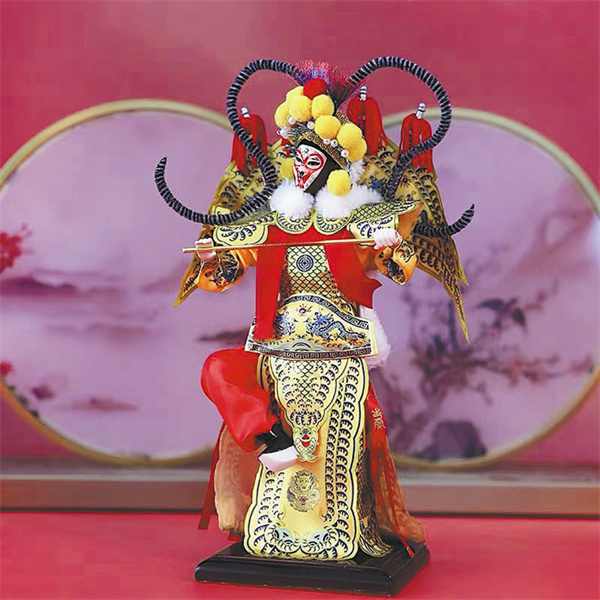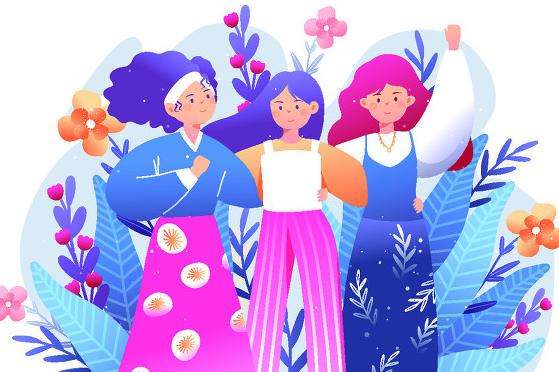Figures from the past have modern appeal


Traditional craft makes a comeback as new technology helps cut costs, Yang Feiyue reports.
Upon entering the Tangrenfang Art of Dolls Museum in the capital city's eastern Tongzhou district, the eye of the visitor is immediately drawn to the more than 100 figurines clad in distinctive and elaborate folk costumes. They range from women in traditional dress to legendary figures from classic novels.
Seen at close quarters, their smooth skin, vivid facial expressions and highly detailed accessories are quite breathtaking.
"They are all traditional juanren, which is, in fact, a type of soft artistic puppet," says Tang Yan, who runs the museum.
Beijing juanren, or Beijing silk figurines, first appeared during the Han Dynasty (206 BC-AD 220) and were popular for centuries. However, after the Qing Dynasty (1644-1911), their production gradually declined and the craft was on the verge of extinction.
In 1954, when China was invited to join an international doll and figurine competition hosted by India, a few artists drew extensively from ethnic groups, classical literature, historical stories, and characters from traditional operas and dances, managing to revive the art of juanren.
The traditional puppets range in height from 16 to 50 centimeters, depicting characters of all ages and genders. However, juanren particularly excels in portraying graceful and charming women.

The craft of making juanren was named a national intangible cultural heritage in 2021.
"The materials mainly include wires to make the skeleton, cotton for the flesh, and the outermost layer of skin is made of real silk gauze. The process is called 'three-dimensional painting'," Tang says.
"In fact, each of our silk figurines has its prototype in history, all originating from folk stories and theatrical characters from various historical periods," she adds.
In addition to the splendid array of delicate dolls, there is a collection of replica costumes from past dynasties, such as one unearthed from the Mawangdui tomb in Hunan province dating back to the Han Dynasty.
"When making silk figurines from the Han Dynasty, we reference its patterns and styles," Tang says.

Diverse styles
The distinctions are easily seen, as the costumes are displayed right next to one another.
"The clothing of the Tang Dynasty (618-907), in comparison (with the Han Dynasty), is particularly vibrant in color, and the patterns are magnificent," Tang explains.
By the time of the Song Dynasty (960-1279), clothing became relatively more tailored, while during the Qing Dynasty (1644-1911), there was a significant use of embroidery in clothing, she adds.
"So, in essence, a small doll embodies the costume culture of various dynasties throughout history," Tang says.
Additionally, juanren integrates multiple examples of intangible cultural heritage. For example, the figurines from the Peking Opera have such elements in their headdresses.
"The silk part on the headdress comes from the art of filigree inlaying, while the patterns on the costumes are hand-painted," she says.
She says every time she makes a silk figurine, it feels like she travels back to ancient China and is able to experience their way of life and the cultural atmosphere firsthand.
"Behind each silk figurine, there is a fascinating story, so it also carries the history and culture of that time," Tang says. Now in her 60s, she has been fascinated with dolls since childhood.
"My mother gave me an old cloth doll. I couldn't keep my hands off it, and I sewed a floral skirt for the doll," she recalls.
"Since then, I have developed an inseparable bond with cloth dolls, to the point of what I can call an obsession."
This early interest resurfaced after Tang built a successful software engineering business in the early 1990s. "I had to find business projects and socialize to build relationships, but it was not the life I enjoy," she recalls.
It was during a trip to a shopping mall in the capital city that Tang first laid eyes on juanren, and was instantly drawn to its delicacy and smooth texture, rekindling a dormant passion.
In 1997, Tang decided to let her husband take over the software engineering business as she pursued her dream.
She first sought apprenticeship with Yang Naihui, the second-generation successor of juanren.
"It was when the traditional craft was at a low ebb, with sluggish market demand and very few people dedicated to carrying it forward," she recalls.
It was during her training that she came to realize there are over 100 steps, big and small. "The craftsmanship is complex and requires mastering everything, such as high-level artistic skills and endurance," she says.
Traditional figurines are made of three layers of fabric. The first two layers are an elastic veil, and the last layer is silk. Then, each layer is pasted one by one, ensuring each is naturally air-dried before pasting the next one.
As such, the production cycle for making a head alone is usually seven to 10 days.
"The most challenging parts are the faces and hands. The fingers of our tiny silk figurines can move, since they have five iron wires inside, wrapped up in cotton and then covered with silk on the outside."
The hand-painted makeup is also demanding, since it's difficult to paint on the three-dimensional silk gauze.
"And, if you make even a slight mistake, everything has to start over," Tang says.
The biggest figurine at the museum stands at 1.2 meters and features a flying, flute-playing fairy that was inspired by the murals at the Mogao Caves in Dunhuang, Gansu province.
"Creating such a dynamic character using silk is particularly challenging, especially when it comes to the face. For a large-faced silk figurine, the demands and tension on the silk are significant, as well as the requirements for craftsmanship," she says.
However, just as Tang started to master the craft, the market response threw cold water on her dream.
"I didn't sell any of the first batch I made," she says, adding that the failure was due to the high price of the dolls, each of which was generally priced between 2,000 yuan ($278) and 3,000 yuan.

Reaching out
That was when Tang took the initiative to make innovation, cut costs and popularize the art.
She found imitation silk, with no visual difference, and hand drawing was replaced by digital printing, all of which greatly enhanced efficiency, cut costs and thus increased productivity.
"However, it is essential to preserve the original elegance and delicacy of the silk figurines, along with the cultural characteristics of the various historical periods," Tang says.
Some traditional techniques, such as twisting silk into flowers, are still used for accessories, such as the phoenix hairpins and tassels on the Peking Opera headdresses.
"The traditional patterns have all been kept as well," Tang says.
Her team has to paint those patterns first, before they are scanned into the computer for printing.
This approach managed to retain the essence of juanren and bring the price down to no more than a few hundred yuan, immediately injecting vitality into the trade.
"They have been snatched up during holiday celebrations," Tang says.
In 2003, Tang established the Tangrenfang museum to further promote the art form.
She first went to the rural areas of southwestern Guizhou and Sichuan provinces to find potential inheritors, who she says are the key for carrying forward the intangible cultural heritage.
"The local girls are naturally skilled in handicrafts, since they learn embroidery, weaving and dyeing from their mothers and grandmothers," Tang says.
Therefore, she has offered them juanren and local intangible cultural heritage training for free, so they can inherit those cultural forms, while picking up new skills and getting job opportunities.
Over the past decade, more than 300 underprivileged girls and women have benefited from Tang's initiative, and approximately 30 have stayed in Tangrenfang to continue their work.
Luo Jinfeng from Guizhou was among the first group of students who joined Tang in crafting Beijing juanren.
"First, we need to understand what the original craftsmanship is like, then combine it with modern development methods, aesthetics and techniques," Luo says.
After Luo came to Beijing a few years ago, she continued her studies in fashion design at the Beijing Institute of Fashion Technology.
She says she hopes to apply the knowledge she has learned at the institute to the design of Beijing juanren.
Tangrenfang has become a popular weekend getaway for many people keen to try their hand at the craft, while enjoying fruit picking, blossoms and fishing.
It is part of Tang's effort to bring Beijing juanren closer to the public.
In the past decade, Tang's dolls have made their way to more than 20 countries, including Germany, France, the United States, Thailand and Singapore.
At cultural exchange events, the Chinese dolls have been highly popular, giving Tang more cultural confidence.
"All the items we took out for display were sold out," Tang says.
Tangrenfang has recently joined hands with the Palace Museum, the National Museum of China, and the Dunhuang Academy to come up with a series of distinctively attired juanren with accessories that are fashioned after relics found at those institutions.
During the recent Spring Festival, Tang fashioned a gift package that features a local fairy guarding the Grand Canal wearing a dragon-like hat.
"We received more than 2,000 orders from companies and social organizations," she says. "It has often been the case at major holidays, especially Spring Festival."
Tang says she has a bigger dream that has yet to be realized: to make Tangrenfang a century-old brand that carries forward and innovates juanren culture.





